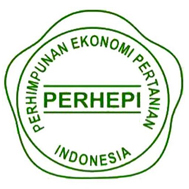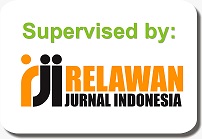RURAL HOUSEHOLD FOOD SECURITY IN KUDUS CENTRAL JAVA
Abstract
Keywords
Full Text:
PDFReferences
Abdullah, S., Zhou, D., Shah, T., Ali, S., Ahmad, W., Bahar, I. Ud. Din., Ilyas, A. (2017), “Factors Affecting Household Food Security in Rural Northern Hinterland od Pakistan”, Journal of the Saudi Society of Agricultural Sciences, S1658-077X(16)30170-9, http://dx.doi.org/10.1016/j.jssas.2017.05.003. [Accessed 7 March 2018]
Amaza, P.S., Umeh, Joseph Chinedu, Helsen, J., Adejobi, A.O. (2006), “Determinants and Measurement of Food Insecurity in Nigeria: Some Empirical Policy Guide”, Annual Meeting, August 12-18, 2006, Queensland, Australia 25357, International Association of Agricultural Economists. https://ageconsearch.umn.edu/record/25357
Bashir, M.K., Steven, S., and Ram, P. (2012), “The Determinants of Rural Household Food Security for Landless Households of the Punjab, Pakistan”, Working Paper 1208, School of Agricultural and Resource Economics. http://www.are.uwa.edu.au [Accessed 7 March 2018]
Devine C.M., Connors M.M., Sobal J. and Bisogni C.A. (2003), “Sandwiching it in: Spillover of Work onto Food Choices and Family Roles in Low- and Moderate-Income Urban Households”, Social Science and Medicine, Vol 56 No.3, pp: 617–630.
FAO. (2010), “The State of Food Insecurity in the World”, Addressing Food Insecurity in Protracted Crises, Rome, 2010, ISBN 978-92-5-106610-2.
Felker-Kantor, E; Wood, C.H. (2012), “Female-Headed Households and Food Insecurity in Brazil”, Food Secur. 2012, Vol. 4, pp: 607–617.
Gani, A. and Biman, C. P. (2007), “Food Security and Human Development”, International Journal of Social Economics, Vol. 34 No. 5, pp: 310-319. Emerald Group Publishing Limited, https://doi.org/10.1108/03068290710741570.
Ilham, N. and Bonar. (2007), “Penggunaan Pangsa Pengeluaran Pangan Sebagai Indikator Komposit Ketahanan Pangan (Food Expenditure Used to Food Security Composite Indicator”, Soca (Socio-Economic of Agriculture and Agribusiness), Vol. 7 No. 3, pp: 1-22 ISSN 1411-7177 3 November 2007, https://ojs.unud.ac.id/index.php/soca /article/view/4217. (In Bahasa Indonesia).
Jebran, K., Abdullah, Iqbal, A. and Ullah, I. (2016), “Effects of Remittances on per Capita Economic Growth of Pakistan”, Pakistan Business, Vol. 18 No. 1, pp: 1–18.
Kartika T.W.W. (2005), “Analisis coping strategy dan ketahanan pangan rumahtangga petani di desa Majasih kecamatan Sliyeg kabupaten Indramayu (Analysis of Coping Strategy and Household Food Security of Farmers in Majasih village, Sub-district Sliyeg, Indramayu district”, Departemen Gizi Masyarakat dan Sumberdaya Keluarga Fakultas Pertanian Institut Pertanian Bogor. (In Bahasa Indonesia).
Khan, R. E. A., Azid, T. and Toseef, M. U. (2012), “Determinants of Food Security in Rural Areas of Pakistan”, International Journal of Social Economic. Vol. 39 Issue: 12, pp: 951-964, Emerald Group Publishing Limited, https:// doi.org/10.1108/03068291211269082.
Mankiw, N. G. and Taylor, M. P. (2006), “Microeconomics”, United Kingdom: Thomson Learning.
Maxwell D., C. Levin, M. A. Klemeseau, M. Rull., S. Morris and C. Alandeke. (2000), “Urban Livelihoods and Food Nutrition Security in Greater Accra, Ghana”, IFPRI in Collaborative with Noguchi Memorial for Medical Research and World Health Organization, Research Report No. 112, Washington, D.C (US).
Mutisya, M., Moses, W. N., Caroline W. K., and Ngianga-bakwin K. (2016), “The Effect of Education on Household Food Security in Two Informal Urban Settlements in Kenya: a Longitudinal Analysis”, Food Security Journal, Vol. 8 No. 4 pp: 743-756, August 2016. [Accessed 7 March 2018]
Olayemi, A. O. (2012): “Effects of Family Size on Household Food Security in Osun State, Nigeria”, Asian Journal of Agriculture and Rural Development, Vol. 2, No. 2, pp: 136-141.
Pandapotan, E. T. (2013), “Pengaruh Variabel Pendidikan, upah, masa kerja dan usia terhadap produktivitas karyawan (studi kasus pada PT. Gandum Malang) (Influence of Variable Education, Wage, Employee and Age of Employee to Employee Productivity (Sase Study at PT. Gandum Malang))”, Jurnal Ilmi Ekonomi, Vol. 1 No. 2 pp: 88-97. E-jurnal: Malang. (In Bahasa Indoensia).
Perpar, A. (2006), “Characteristics of Rural Areas in Slovenia: Advantages, Weaknesses and Possibilities for Improvement of Present Situation from Viewpoint of Sustainable Rural Development”, Journal Central European Agriculture, Vol. 8 No. 2, pp: 229-265.
Purwantini, T. B. and Ariani, M. (2006), “Analisis Konsumsi Pangan Rumah Tangga Pasca Krisis Ekonomi di Provinsi Jawa Barat (Analysis of Consumption of Household Food Post Economic Crisis in West Java Province)”, Jurnal Sosial-Ekonomi Pertanian dan Agribisnis, Vol. 6 No. 1 pp: 1-16 ISSN 1411-7177 https://ojs.unud.ac.id/index.php/soca/article/view/4117. (In Bahasa Indonesia).
Santi, S. and Andrias, D. R. (2005), “Hubungan Ketersediaan Pangan dan Keteraturan Penerimaan Raskin dengan Status Ketahanan Pangan Rumah Tangga Penerima Raskin (Food Availability and Regularity Acceptance of Rice Support with Resilient Household Food Security Status)”, Vol. 10 No. 2 pp: 1-15, http://dx.doi.org/10.20473/mgi.v10i2.97-103. (In Bahasa Indonesia).
Sari, M. R. and Bambang, P. (2009), “Faktor-Faktor yang Mempengaruhi Kerawanan Pangan Rumah Tangga Miskin di Desa Wiru Kecamatan Bringin Kabupaten Semarang (Factors Affecting Poor Household Food Insecurity in Wiru Village, Sub-district of Bringin, Semarang District)”, JEJAK. Vol. 2. No. 2 pp: 135-143 September 2009. (In Bahasa Indonesia).
Sekhampu, T. J. (2012), “Socio-Economic Determinants of Household Food Expenditure in a Low Income Township in South Africa”, Mediterranean Journal of Social Sciences, Vol. 3 No. 3 pp: 449-453 September 2012. Doi: 10.5901/mjss.2012.v3n3p449.
Simatupang, P. (1997), “Toward Sustainable Food Security: The Need for a New Paradigm”, Vol. 99 from Working Paper, CIES, Universiry of Adelaide: ACIAR Indonesia Research Project.
Sinaga, R. J., Lubis, S. N., and Darus, M. B. (2013), “Kajian Faktor-Faktor Sosial Ekonomi Masyarakat Terhadap Ketahanan Pangan Rumah Tangga Di Medan (The Determinant of Social Economy of Community toward Household Food Security in Medan)”, Journal On Social Economic of Agriculture and Agribusiness, Vol. 2 No. 5 pp: 1-13. https://jurnal.usu.ac.id/index.php/ceress/article/view/7876 (In Bahasa Indonesia).
Tasmi, D., Halinda, S. L., and Eka, L. M. (2015), “Hubungan Status Gizi dan Asupan Energi dengan Kelelahan Kerja pada Pekerja di PT. Perkebunan Nusantara I Pabrik Kelapa Sawit Pulau Tiga Tahun 2015 (Relationship Between Nutrition Status and Energy Intake with Work Fatigue on Workers at PT. Perkebunan Nusantara I Pabrik Kelapa Sawit of Pulau Tiga in 2015)”, Jurnal Lingkungan dan Kesehatan Kerja, Vol. 4 No. 2 pp: 1-7. (In Bahasa Indonesia). https://jurnal.usu.ac.id/index.php/lkk/article/view/11297/5777 [Accessed 7 March 2018]
Verma, M., Hertel, W. T., and Preckel, P. V. (2011), “Predicting within country household food expenditure variation using international cross-section estimates”, Economics Letters, Elsevier, Vol. 133 No. 3 pp: 218-220. doi: https://doi.org/10.1016/j.econlet.2011.07.004.
Vuong, T. N., Gallegos, D., and Ramsey, R. (2015), “Household food insecurity, diet, and weight status in a disadvantaged district of Ho Chi Minh City, Vietnam: a cross-sectional study, BMC Public Health, Vol. 15 No. 232, doi: 10.1188/s12889-015-1566-z.
World Bank. (2001), “The World Bank Annual Report 2001: Year in Review (English)”, Washington, DC: World Bank. http://documents.worldbank.org/curated/en/ 624991468764410016/Year-in-review. [Accessed 19 February 2018].
Zakari, S., Liu Y., and Baohui, S. (2014), “Factors Influencing Household Food Security in West Africa: The Case of Southern Niger), Sustainability, Vol 6, No. 3 pp: 1191-1202. https://doi.org/10.3390/su6031191 [Accessed 7 March 2018]
DOI: https://doi.org/10.32528/agribest.v2i2.1629
Refbacks
- There are currently no refbacks.
Copyright (c) 2018 Jurnal Agribest

This work is licensed under a Creative Commons Attribution 4.0 International License.
INDEXING SERVICES
</













